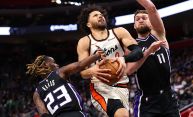
Formula One cars may travel at lightspeed, but their infractions will not go unnoticed by game officials.
There are several rules that F1 drivers need to be mindful of, as in any sport.
The stewards assigned to each race have their eyes peeled to prevent not just an unfair advantage but also accidents. They have the sole authority to hand a specific range of penalties as they see fit.
Range of penalties
Penalties cannot be severe right away. The stewards will assess the severity of the case depending on the impact of the infraction.
Here are the ranges of penalties that a driver or team can receive if they break the rules.
1. Warnings
This is the least harshest penalty a driver can get. This can be applied to situations like unfair blocking or almost triggering a collision.
Some infractions that get a flag and warning are deliberate; others are not. If the driver accumulates a certain number of warnings during a race or the whole season, the penalty can be raised to other forms, such as a fine or time penalty.
2. Reprimands
The next level is reprimand, wherein players could get a grid penalty depending on how many they have incurred. This may be used for in-race infractions or even for those that have nothing to do with the race itself.
3. Time penalties
Stewards may add five or ten seconds in their overall race time for infringements like deliberately forcing another driver off the track. This type of penalty minimizes the impact on the driver's final result while keeping them in check while on the steering wheel. In severe cases, the penalty can go as high as 20 seconds.
Read more : Every F1 Team's Car Reveal Dates
For example, in 2023, Esteban Ocon of Alpine was punished with a hat-trick of time penalties for having his right front tire outside the starting box before the start of the race.
4. Drive-through penalties
A drive-through penalty occurs when a driver violates rules on the pit lane. Drivers must stop completely in the designated penalty area for 5 or 10 seconds before rejoining the race. This penalty is handed to those who commit slight infringements, such as speeding in the pit lane, unsafe releases from a pit stop, or overtaking under yellow flag conditions.
5. Grid Penalties
This penalty is applicable during qualifying, and subjected to this are drivers whose cars have exceeded the engine components more than what was allowed. The grid penalty usually occurs in technical situations like changing engines or mechanical components and altering gearboxes outside of the minimum life cycle.
Guilty teams are made to start from a grid position that is lower than their qualifying result.
6. Disqualifications
If a driver gets a disqualification penalty, they lose their race results and points for the specific race where the punishment occurred.
This applies to grave offenses, including changing the mechanical and technical aspects of the car.
For example, Charles Leclerc's and Lewis Hamilton's cars were found to be using excessive plank during the 2023 United States Grand Prix. For that, they were disqualified.
7. Suspensions
The last level is suspension. Drivers can miss out on several races if they cause crashes.
The last to be punished for this was in 2012 during the Belgian Grand Prix when Romain Grosjean was blamed for a multi-car wreck. McLaren's Lewis Hamilton and Fernando Alonso were involved in the collision. Because of Grosjean's dangerous driving, Sergio Perez and Kamui Kobayashi were also taken out.
© Copyright 2025 Sports World News, All rights reserved. Do not reproduce without permission.










